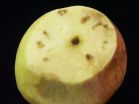(Press-News.org) WALNUT CREEK, Calif. -- For a pest that isn't quite the size of a comma on a keyboard, the two-spotted spider mite can do a disproportionate amount of damage. These web-spinners extract the nutrients they need from leaves of more than a thousand different plant species, including bioenergy feedstocks and food staples. The cost of chemically controlling spider mites to counteract reduced harvest yields hovers around $1 billion annually, reflecting their significant economic impact.
With a 90-million nucleotide genome, the smallest of those that belong to the group of animals with external skeletons or arthropods, the two-spotted spider mite was selected for sequencing in 2007 by the U.S. Department of Energy (DOE) Joint Genome Institute (JGI). "Many aspects of the biology of the spider mite seem to facilitate rapid evolution of pesticide resistance," said DOE JGI collaborator Yves Van de Peer of the Flemish Institute for Biotechnology (VIB) and Ghent University, Belgium. "Control of these mites has become increasingly difficult and the genetic basis of such resistance remains poorly understood."
Van de Peer and others in the research community are now employing the publicly available genomic data from the spider mite to advance the development of novel pest-control strategies that could serve as an alternative to chemical pesticides and reduce environmental pollution. In the November 24 edition of Nature, he and an international team of researchers from more than 30 institutions reported on how the spider mite is shedding light on questions such as the pest's ability to rapidly develop resistance to pesticides, how they can serve more broadly as a model for pest-plant interactions and how they are likely to respond in a changing environment.
"The analysis revealed mechanisms underlying such diverse traits as pest-plant interactions inspiring novel crop plant protection strategies, and the evolutionary innovation of silk production, presenting opportunities for new nanoscale biomaterial development," said the publication's first author Miodrag Grbic of the University of Western Ontario, Canada, and the Instituto de Ciencias de la Vid y el Vino, Logroño, Spain. Grbic was also the project lead in proposing that the spider mite, Tetranychus urticae, be sequenced under the DOE JGI's Community Sequencing Program (CSP). Additional support came from Genome Canada and the Ontario Genomics Institute.
"From a pest management perspective, our colleagues are applying these data as the basis for predicting the effects of climate change on the biology, distribution, and abundance of T. urticae, and as a model system, stimulate advances in similar research for other arthropods," Van de Peer said. Damage of crops by pests represents one of highest energy losses in agricultural production. A tremendous amount of energy is invested in soil tilling, seed distribution, and fertilizer, pesticide, and herbicide application—not counting the energy consumed in the production of those fertilizers and pesticides. Spider mite infestation typically occurs at the late stages of crop development, causing wilt and subsequent degradation that leads to losses of crop and all the associated agricultural inputs.
Of the estimated two million species of mites, less than five percent have been described in any detail. Of this fraction, the spider mite T. urticae is the first of the chelicerate group, which includes spiders, scorpions, and horseshoe crabs, to have its genome completed. Among the arthropods, the tiny pest joins the water flea Daphnia pulex, the first crustacean to have its genome sequenced and published earlier this year by DOE JGI and its collaborators, in the expanding portfolio of biologically-important model systems.
Another discovery associated with the published work was the characterization of genes transferred between species. "It's exciting to identify microbial and fungal genes that have been incorporated into the spider mite genome," said author Jeremy Schmutz, leader of the DOE JGI Plant Program (and faculty investigator at HudsonAlpha Institute for Biotechnology). "It adds evidence supporting the theory of lateral gene transfer as mechanism for plant pathogens to specialize on plants and increase the ability of their population's impact on our food sources." Schmutz goes on to say that part of a larger strategy devised to supplant the use of fossil fuels includes a push to plant out large quantities of cellulosic crops for biofuels, which requires a better understand of the plant interactions with major groups of pathogens. "Most of the genomic work has been done with molds and fungal pathogens, but insects are a major issue for biofuel crops."
The availability of the mite's genome is also fueling research in the biomedical arena, the authors note, including developmental studies characterizing the infectious mechanisms in related organisms, such as ticks that are vectors for Lyme disease and hemorrhagic fever and other mites that trigger allergic responses.
"Like the fruit fly Drosophila and the worm C. elegans, these organisms are rallying points around which pioneering research takes shape," said Jim Bristow, DOE JGI Deputy Director of Science Programs who also oversees the CSP. "It wasn't too long ago when Daphnia had only a handful of dedicated researchers. Now, with the water flea genome available, and its recognition as a keystone species in freshwater ecosystems on the rise, Daphnia research groups number in the hundreds worldwide. This is among our goals in making this information available, to catalyze such energy- and environmentally-relevant fundamental research."
###
Supported by the Office of Biological and Environmental Research in the DOE Office of Science, the DOE JGI's Community Sequencing Program enables scientists from universities and national laboratories around the world to probe the hidden world of microbes and plants for innovative solutions to the nation's major challenges in energy, climate, and environment. Follow the DOE JGI on Twitter and Facebook.
Mite-y genomic resources for bioenergy crop protection
2011-11-24
ELSE PRESS RELEASES FROM THIS DATE:
Caltech scientists point to link between missing synapse protein and abnormal behaviors
2011-11-24
PASADENA, Calif. -- Although many mental illnesses are uniquely human, animals sometimes exhibit abnormal behaviors similar to those seen in humans with psychological disorders. Such behaviors are called endophenotypes. Now, researchers at the California Institute of Technology (Caltech) have found that mice lacking a gene that encodes a particular protein found in the synapses of the brain display a number of endophenotypes associated with schizophrenia and autism spectrum disorders.
The new findings appear in a recent issue of the Journal of Neuroscience, with Mary ...
Scientific sleuths pinpoint the guilty coral killers
2011-11-24
The elusive culprits that are killing countless coral reefs around the world can now be nabbed with technology normally used to diagnose human diseases, marine researchers say.
Coral researchers and reef managers will be able to identify coral infections using a new method that allows them to classify specific diseases based on the presence of microbes.
This could lead to more effective action to reduce the impact of disease on the world's imperilled coral reefs.
"Current classification of coral diseases is mostly based on a description of how the coral has deteriorated, ...
What Is Workers' Compensation in Pennsylvania?
2011-11-24
The Pennsylvania Workers' Compensation Act gives injured workers valuable rights. They include payment of medical bills, wage loss compensation, disfigurement awards for work-related facial and neck scars and awards for specific loss of use of a body part (ex. - leg, hand, finger, etc). The following are key points that workers should know about workers' compensation in Pennsylvania.
Workers' Compensation Benefits for Work-Related Injuries
According to the Pennsylvania Workers' Compensation Act, employers must give their full-time, part-time and seasonal employees ...
Blossom end rot: Transport protein identified
2011-11-24
Blossom end rot on tomatoes and cucumbers, bitter-pit in apples – these unpleasant blemishes on fruits and vegetables not only compromises the flavor but also causes significant harvest losses every year. The characteristic blotches and spotting can be traced back to insufficient calcium uptake or faulty calcium transport within the plant. Consequently, the damage can occur even if the soil provides sufficient calcium. A team under the leadership of scientists from the University of Zurich and Pohang University of Science and Technology, Korea, has for the first time identified ...
Spider mite's secrets revealed
2011-11-24
The tiny two-spotted spider mite (Tetranychus urticae) causes much anxiety for farmers, and has been, to date, a scientific mystery. It feeds on over 1,100 species of plants, including 150 greenhouse plants and crops, such as maize, soy, tomatoes and citrus. The cost of chemically controlling damage caused by the spider mite exceeds USD 1 billion per year. In the latest issue of the journal Nature, a multinational consortium of scientists publish the sequenced genome of the spider mite, revealing how it is capable of such feeding frenzy, as well as other secrets of this ...
Enhanced treatment of brain tumors
2011-11-24
Glioblastoma is regarded as the most malignant form of brain tumor. In many cases, neurosurgeons are not able to remove such tumors completely because of the risk of destroying too much brain tissue in the process. Moreover, it is often impossible to identify all the fine extensions by which the tumor spreads into surrounding healthy tissue. To at least slow down the growth of tumor cells that have remained in the head, almost all glioblastoma patients are treated by radiotherapy after surgery.
"Unfortunately, we can only delay cancerous growth in this way, but we cannot ...
Fault and Liability in California Slip and Fall Accidents
2011-11-24
Countless people sustain injuries each year while on the property of another person or business. Some of these injuries could have been prevented if the owner, manager or occupier of the property had taken basic safety precautions or behaved as a reasonable person would have in the same situation.
Every slip and fall or trip and fall accident does not automatically result in a personal injury claim, but some of them do. It takes a skilled personal injury attorney to know the difference between a frivolous case and one that is likely to succeed. Slip and fall, trip and ...
Closer to a cure for eczema
2011-11-24
Scientists have found that a strain of yeast implicated in inflammatory skin conditions, including eczema, can be killed by certain peptides and could potentially provide a new treatment for these debilitating skin conditions. This research is published today in the Society for Applied Microbiology's journal, Letters in Applied Microbiology.
20% of children in the UK suffer from atopic eczema and whilst this usually clears up in adolescence, 7% of adults will continue to suffer throughout their lifetime. Furthermore, this type of eczema, characterized by dry, itchy, flaking ...
Coming to terms with terror
2011-11-24
How will the terrorist attacks in Norway on 22 July change the country? That question has been put to three social scientists at the University of Stavanger (UiS).
"Norwegians are still in a state of shock," says professor Odd Einar Olsen. "These incidents were so extensive and gruesome that people need time to come to terms with them."
He is very interested to see what content Norway will give to promises made about more openness and democracy after the car-bombing in Oslo and the massacre at Utøya north of the capital.
"While people have united in sorrow, a crippling ...
Winter Weather Is Upon Us: How Drivers Can Stay Safe
2011-11-24
The long, cold Minnesota winters never fail to blanket the state's roadways, causing many weather-related accidents that can range from minor to severe. Minnesota was sixth in the nation for icy road fatalities during the 2009-2010 season, with 18 fatal accidents during that winter.
Minneapolis weather-related auto accident attorneys and other people who work with accident victims understand the danger that comes with winter driving. They encourage safe, cautious driving in the snow, ice and sleet.
Fortunately, there are several things drivers can do to stay safe ...

